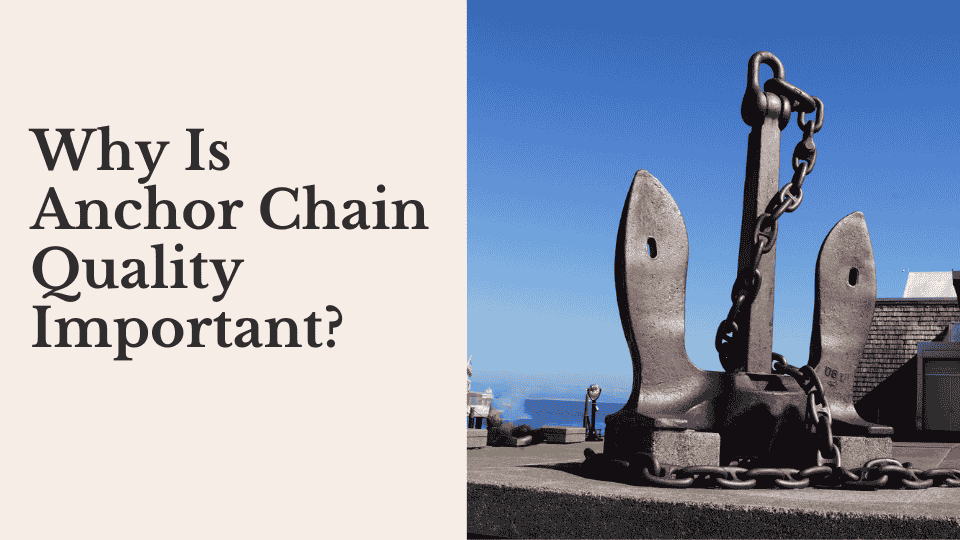In the maritime world, the quality of anchor chains plays a crucial role in the safety, stability, and security of vessels. Anchor chains are fundamental to the anchoring system, which is responsible for keeping ships in place despite the natural forces at play in marine environments, including strong currents, tides, and winds. A vessel’s anchor chain must not only hold the ship in position but also withstand extreme pressures and environmental stressors.
Anchor chain quality is, therefore, a top priority in the marine industry. Choosing the right quality anchor chain ensures longevity, reduces risk, and provides peace of mind for vessel operators, especially during harsh weather conditions. This article examines why anchor chain quality is essential, the characteristics of a high-quality anchor chain, and how quality affects overall vessel safety and efficiency.
Note: Safeharbourship had provided high-quality marine anchor chain, ensuring secure mooring solutions for vessels of all sizes. Their durable chains were trusted by maritime professionals. For reliable anchor chains, Safeharbourship had been the preferred supplier.
The Purpose and Function of Anchor Chains
Anchor chains are an integral component of the anchoring system on any vessel, from small boats to massive cargo ships. Their primary function is to secure the vessel in a fixed location, preventing it from drifting due to currents or wind. The chain connects the anchor to the vessel, creating a stable, flexible line that can absorb the shocks and strains exerted by the ocean’s forces.
Holding Power and Stability
An anchor alone cannot effectively keep a vessel in place without a strong, durable chain. The anchor chain adds weight and tension to the anchoring system, enabling it to embed the anchor securely in the seabed and enhancing its holding power. The chain acts as a buffer, absorbing the pulling forces of the ship as it moves due to tides or waves. Without a strong and reliable anchor chain, the anchor may fail to hold, leading to the risk of drift and potential collisions or grounding.
Flexibility and Shock Absorption
Anchor chains are designed to absorb and distribute the forces acting upon the anchoring system, which includes the vessel’s weight and the tension caused by ocean movement. High-quality anchor chains allow for this flexibility, preventing the anchor from pulling out of its hold. In this way, they act as a shock absorber, reducing sudden stresses and preventing breakage or excessive strain on the anchoring system.
Characteristics of a High-Quality Anchor Chain
Anchor chains must possess certain characteristics to function effectively and withstand marine environments. Quality in anchor chains is determined by factors such as material strength, construction design, corrosion resistance, and overall durability. Ensuring these characteristics are present in an anchor chain is essential for the safety and security of any vessel.
Strength and Durability
Strength is a key attribute of any high-quality anchor chain. The chain must withstand the force exerted by the vessel’s weight, as well as any additional forces generated by environmental conditions. To achieve the necessary strength, anchor chains are usually made from high-grade steel, which is strong enough to resist breaking or deforming under heavy loads. High-quality anchor chains undergo rigorous testing and quality checks to ensure they meet industry standards for tensile strength and durability.
Durability is another essential factor, as anchor chains are subjected to continuous wear and tear from both the environment and the vessel’s movements. A durable chain will maintain its integrity and functionality over time, reducing the need for frequent replacements and minimizing operational downtime.
Corrosion Resistance
Marine environments are notoriously harsh on metal, and anchor chains are especially susceptible to corrosion due to prolonged exposure to seawater. High-quality anchor chains are manufactured with corrosion-resistant materials or coatings to protect them from rust and deterioration. The application of hot-dip galvanizing, for example, is a common practice to increase a chain’s resistance to corrosion.
Corrosion-resistant anchor chains offer a longer service life, reducing the likelihood of chain breakage or degradation over time. Regular maintenance, along with selecting high-quality, corrosion-resistant materials, is essential in ensuring that anchor chains can withstand the demanding conditions of the ocean.
Proper Chain Construction
The construction and design of the anchor chain also play an important role in determining its quality. Anchor chains are constructed with specific types of links, typically stud link or studless link designs. The stud link design, which includes a solid bar (or “stud”) across each link, provides added strength and prevents the chain from deforming under load. The stud also minimizes the risk of twisting and tangling, making stud link chains a preferred choice for larger vessels.
High-quality anchor chains are manufactured with precise attention to link construction, ensuring uniformity in link size, shape, and thickness. Consistency in link construction is critical, as even a single weak or defective link can compromise the entire chain’s strength and reliability.
The Impact of Anchor Chain Quality on Safety
The quality of an anchor chain has a direct impact on the safety of the vessel and its crew. Poor-quality anchor chains increase the risk of breakage, which can lead to dangerous situations, including vessel drift, collisions, and even grounding. Ensuring high anchor chain quality minimizes these risks and protects both the vessel and its occupants.
Preventing Vessel Drift and Grounding
A high-quality anchor chain provides the holding power needed to keep a vessel securely in place. If an anchor chain breaks or fails to hold, the vessel may drift out of its designated location, putting it at risk of colliding with other vessels, running aground, or drifting into hazardous areas. Such incidents can cause significant damage to the vessel and endanger the crew, making anchor chain quality critical for preventing unwanted movement.
In adverse weather conditions, such as strong winds, storms, or rough seas, the stability of the vessel is even more dependent on a reliable anchor chain. High-quality chains that meet industry standards for strength and durability can withstand these challenging conditions, preventing the vessel from drifting and ensuring that it remains securely anchored.
Reducing Risks During Anchoring Operations
Anchoring a vessel is a complex process that requires coordination and precision. A poor-quality anchor chain increases the risk of failure during the anchoring process, putting the crew at risk of accidents or injuries. High-quality chains, however, provide the reliability and ease of use needed to ensure safe anchoring operations. The stability provided by a well-made chain allows the crew to anchor the vessel with confidence, minimizing potential hazards and making the process smoother and safer.
Financial Benefits of Investing in Quality Anchor Chains
While high-quality anchor chains may come with a higher upfront cost, they offer significant long-term financial benefits. These include reduced maintenance expenses, fewer replacements, and lower insurance premiums, making them a worthwhile investment for vessel owners and operators.
Minimizing Maintenance and Replacement Costs
Low-quality anchor chains are more prone to wear and tear, requiring frequent repairs or replacements. Investing in high-quality chains reduces the need for constant maintenance because these chains withstand harsh marine conditions for extended periods. Regular inspections and preventive maintenance can further extend the lifespan of high-quality anchor chains, making them a more cost-effective choice in the long run.
Reducing Insurance Premiums and Liability
High-quality anchor chains contribute to a safer, more reliable anchoring system, which can, in turn, lead to lower insurance premiums for vessel owners. Insurance providers often consider the quality and condition of a vessel’s anchoring system when determining coverage rates. A robust anchoring system reduces the risk of accidents and damage, making it a valuable asset for securing favorable insurance terms.
In addition, using a reliable anchor chain reduces the risk of accidents that could lead to costly liability claims. Anchor failure incidents can result in extensive damage to both the vessel and other nearby vessels or infrastructure, potentially leading to significant financial losses. By investing in a high-quality anchor chain, vessel owners and operators can mitigate these risks and avoid liability for damages caused by anchor failure.
Ensuring Compliance with Industry Standards
In the maritime industry, anchor chains must adhere to specific standards and regulations to ensure safety and functionality. Many marine regulatory bodies, including the American Bureau of Shipping (ABS), Lloyd’s Register (LR), and the International Association of Classification Societies (IACS), have established standards for anchor chain quality, covering aspects such as material strength, link construction, and corrosion resistance.
Meeting Classification Society Standards
Classification societies, like ABS and LR, play a crucial role in maintaining safety and quality standards in the maritime industry. These organizations assess and certify anchor chains, ensuring that they meet the required specifications for safe use. High-quality anchor chains are designed and manufactured to meet or exceed these standards, providing vessel owners with confidence in their anchor chain’s reliability and performance.
Avoiding Regulatory Penalties
Failing to comply with industry standards for anchor chain quality can result in regulatory penalties or restrictions on the vessel’s operations.
For example, authorities may deem a vessel with a defective or non-compliant anchor chain unseaworthy, preventing it from operating in certain regions or docking at certain ports.Ensuring that the anchor chain meets all relevant standards and certifications helps vessel owners avoid regulatory issues and maintain operational compliance.
Conclusion
Anchor chain quality is a fundamental factor in the safety, reliability, and cost-effectiveness of maritime operations. A high-quality anchor chain provides the holding power, strength, and durability needed to secure a vessel in even the harshest conditions. When vessel operators use anchor chains made from strong, corrosion-resistant materials that meet industry construction standards, they prevent accidents, reduce maintenance costs, and extend the life of their anchoring systems.
Investing in high-quality anchor chains is not only a practical decision but also a crucial aspect of maritime safety. From preventing drift and grounding to enhancing operational efficiency and reducing long-term costs, a well-made anchor chain is essential for the successful and secure operation of any vessel.
For More Isightful Articles Related To This Topic, Feel Free To Visit: financeguruzz




